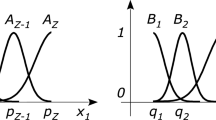Abstract
In this study, orthogonal approximation concept is applied to fuzzy systems. We propose a new useful model adapted from the well-known Sugeno type fuzzy system. The proposed fuzzy model is a generalization of the zero-order Sugeno fuzzy system model. Instead of linear functions in standard Sugeno model, we use nonlinear functions in the consequent part. The nonlinear functions are selected from a trigonometric orthogonal basis. Orthogonal function parameters are trained along with the Sugeno fuzzy system. The proposed model is demonstrated using three simulations—a nonlinear piecewise-continuous scalar function modeling and filtering, nonlinear dynamic system identification, and time series prediction. Finally some performance comparisons are carried out.








Similar content being viewed by others
References
Wang L-X, Mendel JM (1992) Fuzzy basis functions, universal approximation, and orthogonal least squares learning. IEEE Trans Neural Netw 3:807–814
Yen J, Wang L (1999) Simplifying fuzzy rule-based models using orthogonal transformation methods. IEEE Trans Syst Man Cybern-Part B Cybern 1(29):13–24
Wang L, Langari R (1995) Building Sugeno-type models using fuzzy discretization and orthogonal parameter estimation technique. IEEE Trans Fuzzy Syst 3(4):454–458
Campello RJGB, Amaral WC (2002) Takagi-Sugeno fuzzy models within orthonormal basis function framework and their application to process control. In: Proceedings of the 2002 IEEE international conference on fuzzy systems, FUZZ-IEEE’02, vol 2, pp 1399–1404
Campello RJGB, Von Zuben FJ, Amaral WC, Meleiro LAC, Filho RM (2003) Hierarchical fuzzy models within the framework of orthonormal basis function and their application to bioprocess control. Chem Eng Sci 58:4259–4270
Lotfi A, Howarth M, Hull JB (2000) Orthogonal rule-based systems: selection of optimum rules. Neural Comput Appl 9:4–11
Hong X, Harris CJ (2001) A Neurofuzzy network knowledge extraction and extended Gram-Schmidt algorithm for model subspace decomposition. IEEE Trans Fuzzy Syst 11:528–540
Ho DWC, Zhang P-An (2001) Fuzzy wavelet networks for functional learning. IEEE Trans Fuzzy Syst 9:200–211
Lee C-H (2004) Fuzzy Fourier systems for periodic function mapping. J Fuzzy Math 12:933–944
Lee C-H, Lin Y-C (2005) An adaptive neuro-fuzzy filter design via periodic fuzzy neural network. Signal Process 85:401–411
Fausett LV (1999) Applied numerical analysis using Matlab, vol 10. Prentice-Hall, Englewood Cliffs, pp 332–337
Jang J-SR, Sun C-T, Mizutani E (1997) Neuro Fuzzy and soft computing, vol 4. Prentice-Hall, Englewood Cliffs, pp 73–84
Jang J-SR (1993) ANFIS: adaptive-network based fuzzy inference system. IEEE Trans Fuzzy Syst 23:665–685
Chen C-S, Tseng C-S (2004) Performance comparison between the training method and the numerical method of the orthogonal neural network in function approximation. Int J Intell Syst 19:1257–1275
Ljung L (1999) System identification theory for the user. Prentice-Hall, Englewood Cliffs, pp 149–151
Zhang Q, Benveniste A (1992) Wavelet networks. IEEE Trans Neural Netw 3:889–898
Nakamura S (1991) Applied numerical methods with software. Prentice-Hall, Englewood Cliffs
Becerikli Y, Oysal Y (2004) Modeling and prediction with time delay dynamic neural networks. In: 12th Mediterranean conference on control and automation MED’04, Kuşadası, Turkey, 6–9 June 2004
Alci M (1999) Gradient based Fuzzy logic systems depending on training. Ph.D. thesis, SAU
Becerikli Y (2004) On three intelligent systems: dynamic neural, Fuzzy and wavelet networks for training trajectory. Neural Comput Appl (NC&A) 13(4):339–351
Tsoi AC, Tan S (1997) Recurrent neural networks: a constructive algorithm, and its properties. Neurocomputing 15:309–326
Alci M, Becerikli Y, Asyali MH (2005) Orthogonal fuzzy system approximation and its application to time series prediction. Turkish symposium on artificial intelligence & neural networks, TAINN 2005, 16–17. Çeşme, İzmir, Turkey
Chapra SC, Canale RP (1989) Numerical methods for engineers. McGraw-Hill, New York
Author information
Authors and Affiliations
Corresponding author
Rights and permissions
About this article
Cite this article
Alci, M. Fuzzy rule-base driven orthogonal approximation. Neural Comput & Applic 17, 501–507 (2008). https://doi.org/10.1007/s00521-007-0146-2
Received:
Accepted:
Published:
Issue Date:
DOI: https://doi.org/10.1007/s00521-007-0146-2




